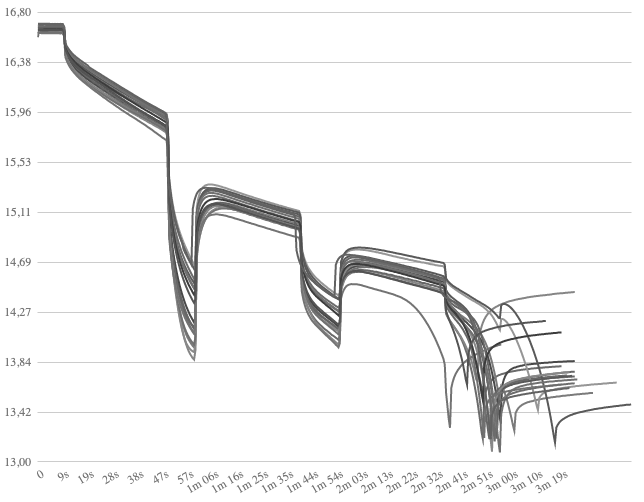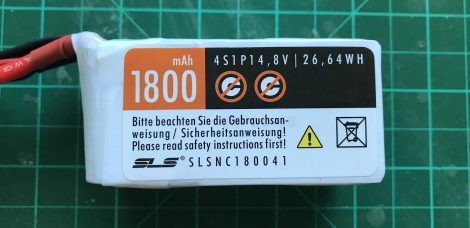Gens Ace has been in the LiPo game for a rather long time already. The portfolio ranges from car batteries to helicopter packs. Latest addition has been the Tattu series which aims at FPV / mini quads. This review looks at the Tattu 75 C rated cells – the 1800 mAh 4S version to be precise.
Appearance
The Tattu series batteries feature a transparent shrink wrapping, allowing a direct view of the single cells. All four sides are covered with a black layer which also holds all printed logos and instructions. Instructions are in English only.
Technical Design
The pack* is a standard 4S1P config flight pack for high power use. Front and back are equipped with some foam protecting the cell edges. A rather special addition: Left and right side of the pack has a build in aluminum plate which protects the cells and optimizes heat dissipation on the outside. It also minimizes puffing under high loads and keeps the pack together nicely.
Build Quality: Very good. Pack feels very well made on the outside. Connection terminal looks solid.
Plugs: All Tattu batteries come with XT60 connectors* pre-installed.
Cables: Gens Aces uses 12 AWG wires on this packs. The high flexible silicon layer is rated up to 200°C. Cable length is about 10 centimeters. Diameter of 12 AWG / 3.31 mm² is standard on this pack type and should be sufficient for mini quad use.
Balacing plugs: Standard XT-system. Balance wires are 4,5 cm which is a benefit in terms of getting them out of the prop-range on the aircraft. The balancing plug features some extra housing adding some protection to the JST XH connectors. Balacing wire and main power line are coming out on different sides of pack’s front.
Technical Details
| Manufacturer | Gens Ace* | 
(Click to enlarge.) |
| Type | Tattu 75 C | |
| Cell chemistry | Lithium Polymere (LiPo) | |
| Cell type | Tattu LiPo | |
| Cell count | 4 | |
| Pack configuration | 4S1P | |
| Capacity | 1800 mAh | |
| Max. Charge Current | 9 A | |
| Max. Discharge Current Continuous Burst |
135 A 270 A |
|
| Weight w/o plugs with plugs |
– |
|
| Measurements as listed measured |
90.3 x 33.27 x 29.9 mm 91 x 33.56 x 29.5 mm |
|
| Price | 38,99 € | |
| Dealer | Amazon.de* | |
| Note | This pack has been bought on the free market. |
Break-in documentation
The battery followed the standard break-in-process: The pack is charged at a rate of 1C until CV-phase ends with current of 1/10C. The break-in phase consists of four charging cycles at 1C and four corresponding discharges at 1 C / 4C / 10C and 20 C.
Anomalies: No anomalies during break-in.
Charging process
Even in normal balancing mode CV phase is rather short (3:22 mins). Cell drift during charge is low.
Load Testing
The main part of this battery test will consists of different load test settings showing the battery performance. Constant load testing is used to judge the advertised C-ratings as well as look at cell drift under high loads. We also check on internal resistance once more. Next up is the dynamic current test, which simulates a „real“ flight with changing (=dynamic) loads. For test methodology please check the dedicated methodology page!
Constant Load Testing
Constant load testing follows a certain load pattern of different constant currents. Base load is 10 C. Current pulses at 50 C, 35 C, 20 C and 30 C are maintained for time intervals between 10 and 20 seconds. For more details please refer to the test methodology page.
Capacity Usage
During this test the pack delivered 1273 mAh. This is 70.7 % of nominal capacity. A very solid value.
Average cell voltages
The following table lists the average voltages per cell, of the total pack, as well as the averaged value per cell as fraction of total voltage during phase of active load.
| Cell 1 | Cell 2 | Cell 3 | Cell 4 | Total | Average per cell | |
| Avg. Voltages | 3.72 V | 3.746 V | 3.748 V | 3.737 V | 14.952 V | 3.738V |
Just looking at average values the Tattu pack performs good. All cells stayed well above 3,7 V on average.
Focus Voltages
Exceptionally interesting when testing a battery under a constant load for a longer period of time: the lowest voltage per cell just before load impulse is disabled. On top, you should have look at voltage recovery rate, that is: how fast do cell voltages rise again once load impulse is cut.
| Phase | Cell 1 | Cell 2 | Cell 3 | Cell 4 | Total |
| End of 50 C | 3.442 V | 3.472 V | 3.506 V | 3.523 V | 13.943 V |
| End of 35 C | 3.459 V | 3.505 V | 3.515 V | 3.521 V | 13.999 V |
| End of 20 C | 3.248 V | 3.494 V | 3.509 V | 3.466 V | 13.718 V |
| End of 30 C | – | – | – | – | – |
On the 50 C pulse the singe cells dropped well below the 3,5 V mark, indicating that the pack was quiet busy delivering 50 C (90.0 A). The 35 C and 20 C have been handled well, though. You can see cell #1 drifting rather strong.
Average voltage recovery per second
Those values are specific to the test setting and not valid for the pack in general! Still they allow an estimated guess about how fast voltages rise again after current spikes.
| Cell 1 | Cell 2 | Cell 3 | Cell 4 | Total | |
| Avg. Recovery | 0.0503 V / s | 0.0465 V / s | 0.0425 V / s | 0.0384 V / s | 0.1776 |
Even though voltages dropped down pretty strong during current pulses the recovery rates show that the pack is able to recover voltage pretty fast when switched from current pulse to base load.
IR-Measurement
IR measurement is conducted using the four current pulses. Resistance for each cell is calculated in all four discharge phases. Shown values are averaged to cancel out different temperature points due to different discharge states during measurements.
| Cell | 1 | 2 | 3 | 4 | Total |
| Resistance [mΩ] | 2.82 | 2.51 | 2.26 | 2.41 | 10.0 |
Interpretation: The internal resistance of 2.50 mΩ average per cell indicates a „true“ C-rating of around 37 C (65.7 A). This is on the conservative side and represents a current draw that will make the pack last for a long time. See load testing for further categorization. The pack had no problems delivering during high C discharge pulses. Looking at the claimed 75C rating this pack seems a little bit overrated.
Cell drift under load
| Discharge Phase | 50 C | 35 C | 20 C | 30 C |
| Max Cell drift (V) | 0,041 V | 0,063 V | 0,261 V | – |
Key Temperature Facts
Temperature Development
All temperature probes reported values below cut-off point at 58°C. Max. temp during discharge was around 57,9 °C on top of pack. The battery had to be actively cooled down right after cut-off to prevent further temperature increase. Note that heating of stressed LiPo packs will continue for some more time even when load is cut.
Market Comparison
The following chart shows all reviewed LiPos in the same product segment for direct comparison of performance. Higher values under load are better.
Constant 25 C Discharge
Pretty much a standard benchmark in the LiPo industry.
Cut-Off /warning value for this battery should be chosen between 3,5 V and 3,45 V minimum. Usable capacity until cut-off: 1206 mAh (67 %).
Market Overview
Comparison of different reviewed 1800 mAh batteries under 25 C load.
Dynamic Load Testing
The dynamic load testing setting consists of two separate discharge scenarios that have been developed of two different real-life FPV flights. Pattern one represents a high speed low proximity flight around the open field with some hovering to the end. Average load is around 22 A. Second pattern is a free-style flight around trees in the park with some current spikes near 70 A. Average load on this flight is around 13 A due to longer floating periods.
Capacity Usage
During the test of pattern 1 the pack delivered 1170 mAh. This is 65 % of nominal capacity. In pattern 2 the Tattu pack yielded 1193 mAh. That’s 66,3 % of nominal capacity.
Market Comparison
The following charts give an overview of all tested packs in the 1800 mAh class so far.
The last chart of this review sums up the usable capacity during all four load scenarios. Please note that this is only the capacity consumed by the electronic load! There are losses due to heating of the pack, which could be approximated (see testing methodology page). All four tests are cut when any cell goes below cut-off voltage of 3,3 V (or pack goes above 58 °C on any of the three probes). If you would push further and go down to 3,0 V/cell you will be able to squeeze out some mAh more, but at the cost of excessive heat generation and shortening of pack life-span. This value will most likely differ from what you get when flying on a quad as most people don’t monitor voltage on a per cell basis and therefore don’t even notice if voltage drops below 3,3 V/cell during punsh-outs (what’s not necessarily a good thing, though). For comparison, used capacity until 3,3 V/cell is reached is the base line in all battery reviews on Drone-Zone.de.
Conclusion
The Gens Ace Tattu 4S 1800 mAh 75 C battery* is a very compact pack with a good capacity to weight ratio of 9.09 mAh/g. The measurements are fairly small compared to other packs in the same capacity class (- 10mm in length). Build quality of the Tattu pack is solid. The two aluminum sheets on either side, on the one hand make it look nice and on the other hand inhibit excessive puffing under high loads. Voltage stability is alright on average, high current drains (at 50 C e.g.) let the pack drop below 3,5 V / cell. Average cell voltages have been good, though. Voltage recovery rate is really good on this Tattu battery. Short voltage drops due to high current spikes are recovered quickly. The 75 C rating is a good bit over the top. For constant current draws you should not exceed 35-40 C, while performance spikes should stay below 50 C to not decrease the lifespan of the cells unnecessarily. Usable capacity is very high on this pack, which is a result of the fast voltage recovery rate, as well. Temperatures and cell drift have been fine during testing. The price of 39 € is a little above average for this capacity class. Still the quality of the pack justifies a little premium.
Other packs of this line up tested:














